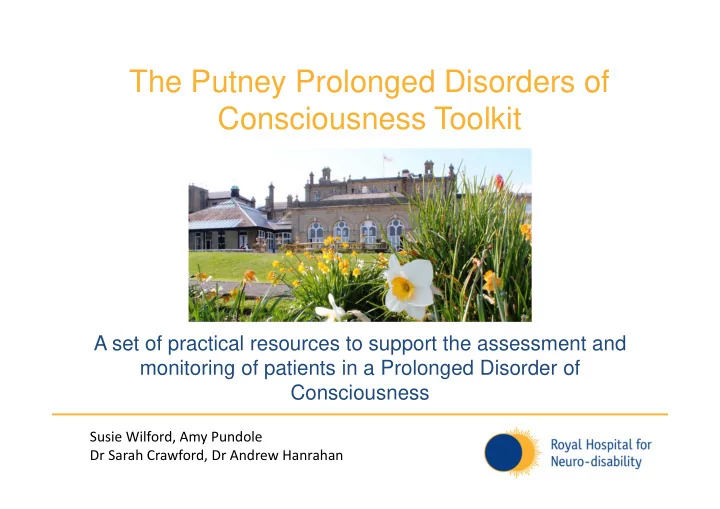

The Putney Prolonged Disorders of Consciousness Toolkit A set of practical resources to support the assessment and monitoring of patients in a Prolonged Disorder of Consciousness Susie Wilford, Amy Pundole Dr Sarah Crawford, Dr Andrew Hanrahan
Contents • Rationale • The Putney PDOC Toolkit 24 hour management o Behavioural observations o Emotional responses o Interactions o Functional object use o Command following o Swallowing o Individual assessment plans o Emergence o Monitoring o
Rationale Informal assessment Toolkit is a set of resources to support assessment and monitoring Set of non-standardised assessments Aims to support patient-centred assessment in a more flexible way Supports clinicians to clinically evaluate behaviours in areas of uncertainty
Rationale Informal assessment Supports the formal assessment process Enables clinicians to collect evidence, in a meaningful environment, on behaviours to: • Support diagnosis • Support family/carer education • Identify and signpost the highest level of response that can be further explored
How do we build a picture of a patient in a PDOC? WHICH WHICH MAIN ASSESSMENT ASSESSMENT THEMES TOOL? TOOL? WHIM ? WHIM ? WHIM ? WHIM ? Patient Patient SMART ? SMART ? SMART ? SMART ? characteristics OUTCOMES characteristics CRS-R ? CRS-R ? CRS-R ? CRS-R ? OTHER ? No one OTHER ? OTHER ? OTHER ? No one Assessment Assessment assessment Assessment assessment characteristics characteristics characteristics tool is perfect tool is perfect Combine 2 or Combine 2 or Pragmatics Pragmatics Pragmatics more tools Pragmatics more tools
24 hour management • Recording and fostering regular sleep-wake patterns • Creating an environment with light and dark periods • Consider the environment in all contexts • How to ensure the individual is best supported to be able to demonstrate what they are able to do
24 hour management • Weekly planner • ‘Help me get a good rest’ guidelines • Arousal monitoring • Arousal chart (24 hours)
Behavioural Observations • Need to understand what the patient is doing at rest when no stimuli have been applied
Behavioural Observations Eye Movement Observations Tally of number of blinks • Direction of the eyes • Observations • Tally Charts Tally Charts
Emotional Responses • Range of behaviours that are usually linked with emotions, such as tears, grimacing, smiling • Difficult to score on formal tools • Individualised approach that avoids words such as ‘depression’ and ‘pain’ and focuses instead on behaviours. • Use a flow chart when team raise concerns about low mood • Measure behaviours before, during and after treatment (antidepressants/neurostimulants/behavioural activation)
Emotional Responses
Interactions • Lack reliable communication • We set up the environment to promote appropriate interaction/communication wherever possible • Chat Mat – what to talk about • Communication passport – how to talk to me • ‘Help me fill my free time’ ‐ appropriate leisure activities and how to monitor
Chat Mat [ Insert photo of patient here ]
Communication Passport
Functional Objects • Emergence criteria • Functional assessment with everyday familiar objects • Record which objects trialled, how they are held and manipulated • Do they use the object appropriately
Using objects
Following Commands • Used to distinguish VS/MCS • Need individual approach • ‘Top tips’ • Pick right command • Compare to movements at rest • Try rewording or modelling
Swallowing The 2013 RCP PDOC guidelines consider oral feeding a form of • sensory stimulation • Intentional behaviours such as anticipatory mouth opening or licking residue from lips • Additional information on interaction, communication and awareness by providing a functional context in which to communicate likes/dislike/choices/’more’ • Little research in this area • Practical ideas for SLTs • What to look for in PDOC swallow assessment Guidance on clinical reasoning and best interests decision making •
Swallowing
Individual Assessment Plans
Emergence • Based on suggestions from RCP guidelines • Yes/no and discrimination tasks using autobiographical information, everyday objects and colours • Items visually, semantically and phonologically distinct
Monitoring Annual Reviews Week Programme outline • 6 week programme Prior to week one • Screening form completed by MDT • Looks at behaviours Week one Staff planning • • Seen in either a group • Information given to setting and/or 1:1 family • First group • Minimum of 4 sessions Weeks 2 – 4 • Groups 2 – 4 • WHIM completed with all • Individual sessions patients Weeks 5 ‐ 6 Results collated • • CRS-R if used previously • Summary report • Actions identified and an • Summary report action plan put in place
Monitoring Annual Reviews – Groups Sensory Art Group Activities can be varied • • Using items from the garden based on the patient’s such as herbs/ leaves, interests/preferences • Using clay and paint • Provides an opportunity for patients to respond to a range of sensory stimuli Sensory Baking Group within a meaningful and • Making a variety of sweet familiar activity and savoury treats based on previous preferences • Patients supported to look at, hear, touch and smell
Any questions? Ideas?
Contact details Susie Wilford Senior I Occupational Therapist swilford@rhn.org.uk Amy Pundole Clinical Lead Speech and Language Therapist apundole@rhn.org.uk Dr Sarah Crawford Consultant Clinical Neuropsychologist & Professional Lead for Clinical Psychology scrawford@rhn.org.uk Dr Andrew Hanrahan Consultant in Neuro-rehabilitation; Lead Consultant Brain Injury Service ahanrahan@rhn.org.uk
Recommend
More recommend